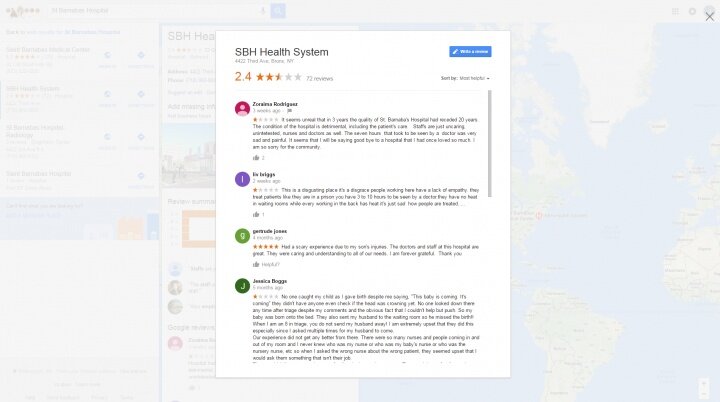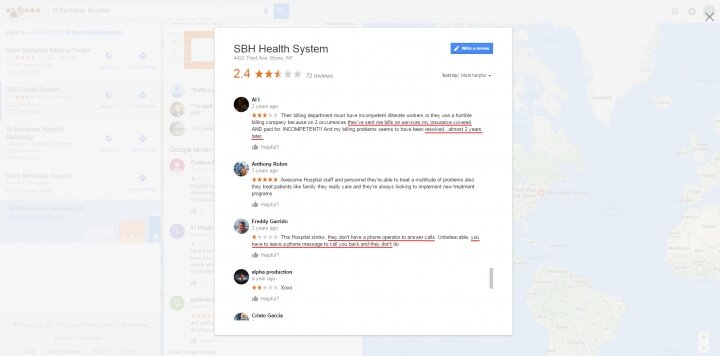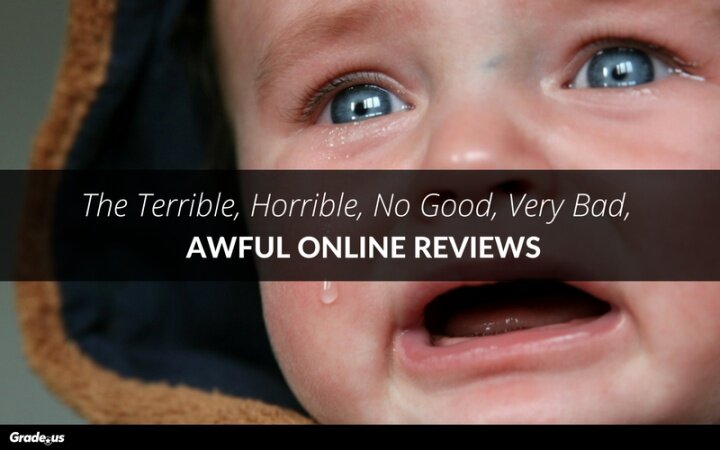- Joined
- Mar 15, 2016
- Messages
- 474
- Reaction score
- 252
The Terrible, Horrible, No Good, Very Bad, Awful Online Reviews
Any examples of clients with awful customer service that has resulted in awful reviews?
Have you ever been able to impact a company's customer service philosophy to actually turn around their ORMM? What was the best tactic you used to get owner and employee buy-in?
Read Andrew's entire article here.



The Terrible, Horrible, No Good, Very Bad, Awful Online Reviews
John Verrier is dying.
He went to the St. Barnabas hospital’s ER to get his rash checked out. He was in an incredible amount of pain and he was fading… fast. But hospital staff ignored him.
He waited 8 hours for help.
Then he died.
At 6:40 the next morning a security guard found John’s dead body slumped over in his chair. A staff member said he was cold, blue and stiff stating he was dead for several hours.
St. Barnabas’ excuse? They were understaffed.
Their excuse made the situation so much worse
The hospital created this disaster then, when it came, they did everything they could to cover it up. They lied about it. They hid behind HIPAA, they warned employees to be quiet.
Naturally this created an incredible amount of anger and negative sentiment.
The public was understandably upset. They wanted to be heard, they wanted the hospital to make things right – to own up to their mistakes. But their horrible service created the negative reviews and backlash they received.

Bad service = negative reviews.
That’s common sense right? John Verrier’s story is as extreme as it gets which is why there was such an awful backlash when his story came out. But a bad review itself isn’t truly awful. Bad reviews turn customers away temporarily. Late delivery, things weren’t as expected, can’t get the help you need, etc. Kind of like this:

Fix these issues and eventually, customers come back.
Not the case with a truly awful review.
The ‘truly awful’ review is permanent
And so are the damaging effects. But why? What makes the “truly awful” review so much worse than a negative review? What does it matter if it’s bad or awful, aren’t they both the same?
Not so much.
A truly awful review is far more damaging because it’s foundational. It exposes the company’s character, attitude, values and beliefs. Take this review for example:

Sandy had a horrible Thanksgiving dinner. She spent $200 dollars on a meal for her family and things went badly. She’s direct and pretty blunt, which I imagine stings a bit.
At this point, the restaurant has a choice to make.
Do they confirm to prospective customers that this restaurant is pretty awful? Or do they try to make things right?
They make things worse.
Marc, the chef at Pigalle Boston, decides to curse(!) at his unhappy customer calling her all kinds of nasty names. He tells her to come back for her money, he attacks her character.
His attack confirms her accusations, and EVERYONE can see it on this public channel.
Marc lost his temper showing the whole world his character, attitude, values and beliefs. His behavior tells everyone that Sandy was right about his restaurant.
And attacking customers isn’t the only way to earn truly awful reviews.
Regardless of industry, these days, you just need to make one particular mistake, and you’re asking for trouble. When you ignore this foundational principle, you’re on your way to earning truly awful reviews.
What mistake am I talking about?
Poor presentation
When we hear the word ‘presentation’ most of us think of PowerPoint slides, a speech or graphic design. But presentation is much, much more than that.
Presentation is a vehicle. It’s a mixture of tangible and intangible factors working together.
- Tangible. The quality of your product, how you look, visuals – the taste, texture and smells associated with your product. Tangible typically includes sensory details, things you can touch, taste, see, smell, interact with, etc.
- Intangible. The beliefs, behavior, culture, values and temperament of your business. These are the important details customers can’t see but desperately want to know about.
Here’s an important detail that most people miss.
Customers use the tangible (things they can see, smell, taste, touch, hear) to tell them about the intangible, things they can’t use their senses to experience.
Here’s what that looks like.

This is a truly awful review. It’s pretty obvious right?
Here’s why this is so awful
This review reveals an intangible problem. Deep defects of character that indicate this hotel is untrustworthy and unsafe. The tangible speaks volumes about the intangible which is much harder to fix.
Let’s break it down.
Tangible: blood stained headboards
Intangible: questionable things happen here.
Tangible: no hot water
Intangible: owners aren’t interested in providing basic amenities but still want my money.
Tangible: Poo in the kettle
Intangible: Their hotel is dirty, full of disease, and definitely unsafe.
Customers make all kinds of intangible conclusions based on the tangible details they see. The tangible/intangible impacts industries that aren’t typically judged on tangible components. A doctor may offer incredible service and still get bad reviews because his waiting room is filthy. Customers judge based on the tangible details they notice at any point during your relationship.
And that’s the problem.
These intangible details can be fixed, if you have lots of time and people are willing to give you the benefit of the doubt. But most customers won’t.
Because the intangibles tell customers who you really are
They answer deep, weighty questions like…
- Can I trust you?
- Why should I choose you?
- Will you hurt me?
- What if you get it wrong?
Give customers the wrong answers to their tangible and intangible questions and they simply move on, no harm no foul.
Share the right answers to their questions and they convert. They sign-up, buy, opt-in, etc. They take the action you’d like them to take.
The problem? Winning customers over creates danger.
Because customers believe you’re a fit. Because they believe the intangible details – character, beliefs, values, temperament, etc. – are compatible with their own.
As a business, you’re left with two options:
Be superior. This means you go above and beyond their expectations. You go out of your way to give them an experience that’s much better than they anticipated.
Be inferior. You go out of your way to give them less than they anticipated. You consistently over-promise and under deliver. What about adequate? Adequate is still inferior.
Both options create a desire to share the details with customers; superior outcomes create happiness and joy while inferior outcomes create pain and anger. And as research shows, anger is a far better motivator than happiness.
Any examples of clients with awful customer service that has resulted in awful reviews?
Have you ever been able to impact a company's customer service philosophy to actually turn around their ORMM? What was the best tactic you used to get owner and employee buy-in?
Read Andrew's entire article here.





